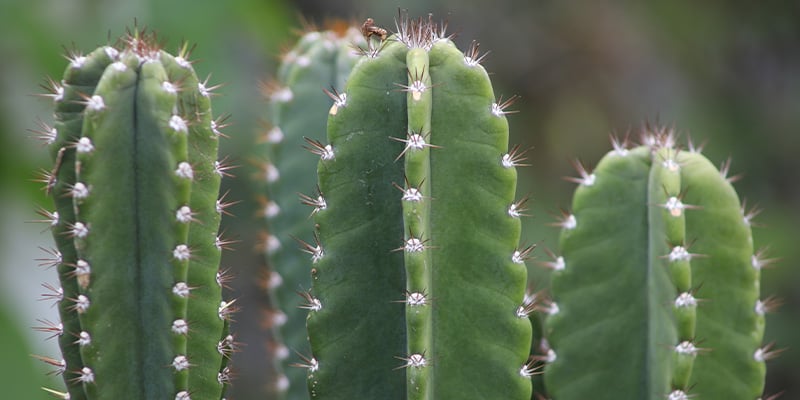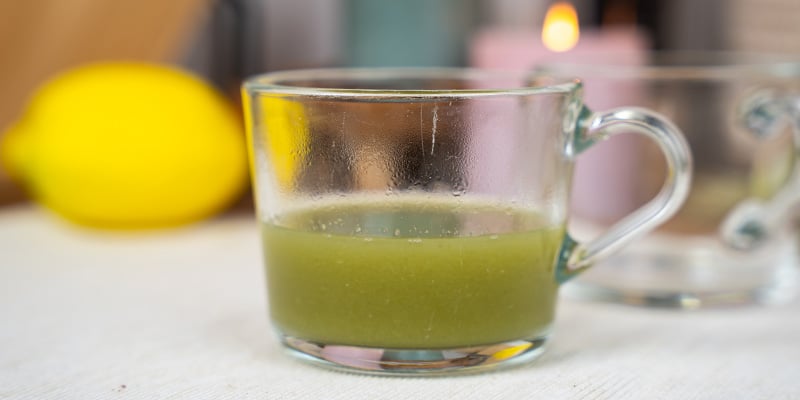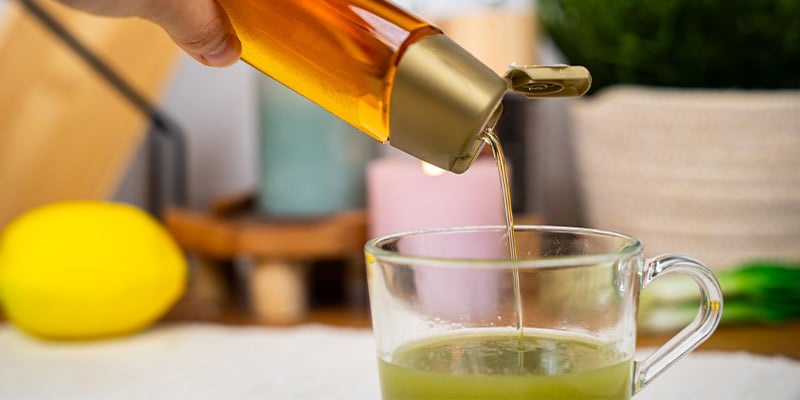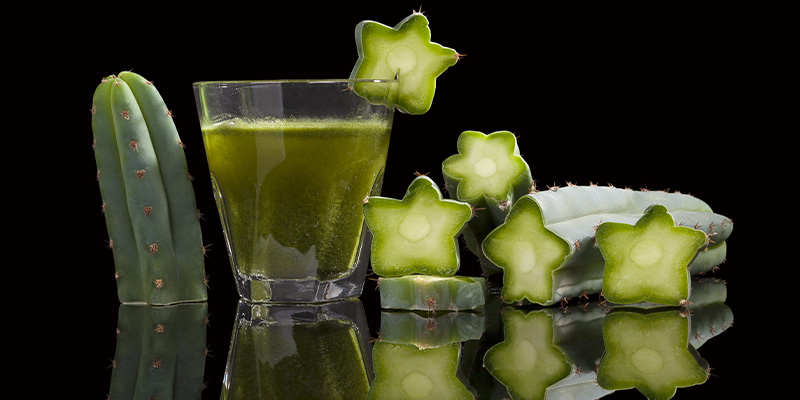How to make san pedro tea

- Fresh San Pedro cactus
- Lemon (optional)
- Large pot
- Knife and cutting board
- Blender or food processor (optional but recommended)
- Strainer or cheesecloth
- Container for the tea
People have been drinking San Pedro tea for thousands of years in order to imbibe its revelatory psychedelic properties. Here we provide some context on the history of this tradition, followed by easy steps on how to make San Pedro tea at home.
San Pedro tea, derived from the San Pedro cactus (Echinopsis pachanoi), is a traditional South American brew known for its high mescaline content, which has long been used in traditional cultural practices in the Andes. za, a phenethylamine alkaloid, is a naturally occurring psychedelic present in a range of cacti found throughout the Americas.
There are a few ways to ingest mescaline, but brewing a tea is one of the most straightforward. So in this article, we’ll explore a little of the history of this brew, and then look at how to make your own San Pedro tea at home.
What is San Pedro tea and how is it traditionally made?

The preparation of San Pedro typically involves cutting the cactus into small pieces, boiling it for several hours, and then straining the liquid to create the tea. Traditionally, the process is quite simple, and more or less the same as the one we’ll outline below. However, the ritual surrounding the consumption of tea has quite some history. This history is diverse, vibrant, and actually still a contemporary reality, and we won’t be able to do it justice here. However, here’s a little overview of huachuma (San Pedro) ceremonies.
Various cultures have and still use San Pedro, and it’s thought that the earliest use might date back to around 3500 BCE, at the Chavin site. Although practices differ, a common ceremony might begin with a shaman and user fasting for 24 hours. After this period of fasting, they would head to a mesa (altar), usually at night on a Tuesday or Friday—important days in Andean religious culture. Then, the user would take an infusion of tobacco in water up their nose to cleanse and defend them. After this, the San Pedro tea would be consumed, and any healing/religious rituals would take place. Rituals may also include other people to strengthen the experience, as well as music, incense, or other additions.
Does drinking mescaline cactus juice make you hallucinate?

In the common vernacular, yes. However, technically it won’t make you hallucinate unless taken in very high doses. In fact, most psychedelics, excluding DMT, don’t usually cause true hallucinations, rather they significantly alter perception. A hallucination is the name given to a sensory experience that has no stimuli in the outer world—whereas the mescaline experience usually works with the world as it is, even if it is significantly changed from the sober one!
Nevertheless, mescaline is a powerful hallucinogen (the name can be confusing) that can alter perception, mood, and cognitive processes. Users often report visual and auditory experiences, a heightened sense of awareness, and deep introspective experiences—all of which can add to its ritualistic, healing, and recreational properties.
How to make San Pedro tea: Step-by-step
Now that you know a little more about this psychoactive plant, let’s take a look at how to brew mescaline cacti into a tea for a psychedelic trip.
Equipment
- Fresh San Pedro cactus
- Large pot
- Knife and cutting board
- Blender or food processor (optional but recommended)
- Strainer or cheesecloth
- Container for the tea
- Lemon (optional)
Directions
These directions will be split into two parts: preparation and the brewing of the tea.
Preparing your San Pedro cactus
Before you start brewing, you'll need to prepare your San Pedro cactus properly in order to get the best effects while mitigating stomach issues. To do this, you must remove the spines and peel the outer skin. Here’s how to prepare San Pedro cactus for brewing.
1. Clean the cactus: Rinse the cactus under cold water to remove any dirt or other impurities.

2. Remove the spines: Carefully cut off the spines with a knife or peeler, but don’t cut too deep as you don’t want to damage the inner flesh.

3. Peel the cactus: Remove the outer, waxy layer of skin, exposing the greener, lighter skin underneath. Be very careful when doing this, as the lighter green layer of skin beneath the outer layer is said to contain the highest concentration of mescaline, and therefore should be protected.

4. Cut into pieces: Slice the cactus into small, manageable pieces for easier processing. These can be any shape or size.

5. Remove inner flesh (optional): Some say that by removing the white, inner flesh, the taste can be improved and that the stomach will find the whole experience easier. This step is not necessary to make the tea, but it can be helpful for a better experience.
Brewing the tea
1. Blend the pieces (optional): First, blend the cactus pieces to create a pulp. This can help to extract more mescaline during boiling and, although it is not necessary, will make the whole process more efficient and the tea more potent.

2. Boil the cactus: Place the cactus pieces or pulp into a large pot and add enough water to cover them. Bring to a boil, then reduce the heat and simmer for at least six hours while the mescaline is extracted into the water. Stir occasionally and add more water if needed to keep the cactus submerged—you don’t want it drying out.

3. Add lemon (optional): Many people choose to add lemon to the mixture as it’s thought that the acid helps to catalyse the extraction. Although this isn’t proven, acid helps with the extraction of various other psychoactive substances, so it may well be true with mescaline too.

4. Strain the mixture: After simmering for at least six hours, strain the mixture through a cheesecloth or fine strainer to separate the liquid from the solid material, which should now be devoid of psychoactive mescaline. Squeeze out as much liquid as possible from the cactus pulp, as this liquid is where the mescaline is present, so you want to retain as much of it as possible.

5. Reduce the liquid: Return the strained liquid to the pot and simmer until the volume is reduced to your desired concentration. Some people reduce it to a shot’s worth so it is easy to consume. This will taste pretty rough but is over and done with in no time! This reduction step can take another few hours, so be patient.

6. Cool and use/store: Allow the tea to cool, then store it in a container or take it immediately. It can be kept in the refrigerator for a few days, so it is easy enough to prepare in advance.

How much San Pedro tea should you drink?

Dosing San Pedro tea can vary widely depending on the potency of the cactus and individual tolerance, so you’ll always need to employ some educated guesswork. The trick is to try to figure out how much mescaline is in your cactus cutting before you make the tea, and dose it this way.
General wisdom states that a cutting roughly the length of a forearm (40–50cm) contains about a normal dose of mescaline. Others suggest going by weight. Although a very rough estimate, it is thought that in a standard San Pedro cactus, there is about 1mg of mescaline for every gram of fresh cactus.
A standard dose of mescaline is around 200–300mg, so around 200–300 grams of fresh (unprepared) cactus should be adequate for one person’s trip.
Do not try to dose by millimetres of tea, as this can vary in concentration depending on how much it’s been simmered. Less liquid does not mean less mescaline!
Hints and tips for making San Pedro tea

Though we’ve covered the basics, the following tips might help to make the experience of preparing the tea more efficient, and the results better too.
- Masking the taste: The tea can be bitter and pretty unpleasant. Adding honey, ginger, or lemon can improve the flavour and, in the case of the latter, possibly aid extraction.
- Cactus varieties: While San Pedro is commonly used, the Peruvian and Bolivian torch cacti—Echinopsis peruviana and Echinopsis lageniformis, respectively—are other varieties known for their high mescaline content. San Pedro’s spines are very small, while Peruvian and Bolivian Torch have longer spines. The process for making tea from any of these varieties is the same, barring dosing.
- Reducing nausea: Some people add herbs like peppermint or chamomile to the brew to reduce nausea and also to enhance the flavour. Otherwise, people might consume a separate, soothing tea prior to drinking the mescaline concoction.
- Freezing: Freezing the cactus pieces before boiling can help to break down cell walls, making the mescaline extraction more efficient and the final product stronger. Go through the preparation stage as listed above and then freeze the cactus once it’s been cut up into smaller pieces, otherwise trying to prepare it will be challenging!
Possible risks of San Pedro tea

While San Pedro tea can provide profound experiences, it also carries risks:
- Nausea and vomiting: These are common side effects due to the bitter taste and potent compounds.
- Overwhelming effects: The experience can be intense and disorienting, particularly for first-time users.
- Mental health effects: Those with a history of mental illness should avoid mescaline, as it can exacerbate conditions like anxiety or schizophrenia.
- Legal issues: Mescaline is illegal in many countries. Ensure you are aware of and comply with local laws.
Harnessing the power of ancient traditions

If you drink San Pedro tea, you’ll be following thousands of years of psychedelic tradition. Whether you want a life-changing experience, or just a recreational experience, San Pedro can absolutely offer this to you. Making the tea is pretty easy, but ensure you do your research on this plant and its effects, and using psychedelics more generally, before embarking on this adventure. Generally, these compounds will hold your hand, but preparation and respect is key to having a positive experience!












 United States
United States













